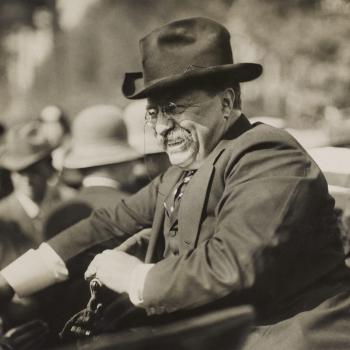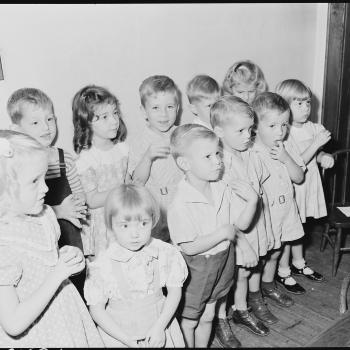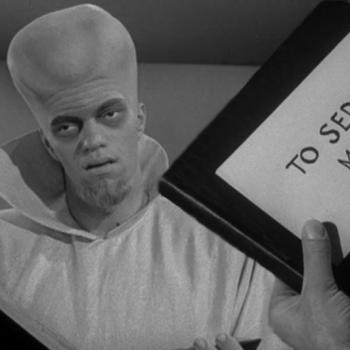The last time we noticed evangelical spokesmen engaging in nostalgia for a winsome and appealing expression of evangelicalism, Tim Keller was massaging the circumstances of his identification with the movement for the New Yorker magazine. Now Greg Thornbury takes a stroll down a similarly nostalgic path. Both Keller and Thornbury romanticize the 1970s. Keller actually lived through them and should know better. Thornbury was still teething and learning to walk during the decade. Keller left out Jim Bakker and PTL. Thornbury argues that because Larry Norman was a Christian rocker who signed with “secular” record companies, evangelicalism was mainstream. The movement only turned political once Jerry Falwell (the elder) and James Dobson showed up to back the Republican Party.
(An aside: the image for Thornbury’s piece makes no sense. It features Larry Norman and Jimmy Carter when the former visited the White House in 1979. So we are supposed to believe that evangelicals were showing up at the White House BEFORE they entered the political fray, as if getting in the White House is just like an ordinary American using the Library of Congress. Carter, the man who inspired Newsweek editors to identify 1976 as the Year of the Evangelical, was POTUS. But this was before evangelicals were political. Well.)
The high water mark for evangelicalism’s mainstream standing was the Jesus Movement (or Jesus Freaks — I wonder if that was what prompted Tim Keller to sign on.):
over 100,000 teenagers — dubbed “Jesus Freaks” by the media — crowded into the stadium to hear the evangelist Billy Graham preach and to listen to their favorite Christian musicians perform, chief among them being Johnny Cash, Kris Kristofferson, the black gospel singer Andraé Crouch and Norman. Time magazine ran a cover story on the phenomenon as a leading national news item, calling Norman “the top solo artist in his field.” Life did the same and expressed fascination with this non-free-love, peace-loving and drug-free version of the hippies. Soon, Graham himself would feel burned by getting too close to Richard Nixon and naively defending the president before the truth about Watergate was known. From that point onward, the nation’s most famous preacher shied away from political jockeying and generally stuck close to his core message, which was basically, “God loves you. Jesus died for you.”
Evangelicals had a social conscience too, though, in the 1970s, and, for a brief moment, showed promise as a group of people who now had positions of leadership in America. Newsweek dubbed 1976, “The Year of the Evangelical.” Jimmy Carter, a Baptist Sunday school teacher, professed a “personal relationship with Jesus Christ” and was elected president. Graham broadcast his nationally televised “crusades,” held in packed-out stadiums, and was a guest on “The Dick Cavett Show.” Author Francis Schaeffer was so popular with college students that purportedly even rock stars like Eric Clapton and Jimmy Page were reading his books. By 1979, Bob Dylan made headlines by claiming he had become a “born again” follower of Jesus. The newly converted Dylan began attending church at the Vineyard fellowship, a Bible study that began, appropriately enough, in Norman’s living room.
See what Thornbury did there? He noticed that some rock stars were reading Francis Schaeffer and that kind of popularity was a different animal from what transpired when the Moral Majority arose:
Ronald Reagan found a different cadre of Christians with whom to share common cause and rock the vote. The relatively apolitical Graham was overshadowed by new voices in the “Moral Majority.” Television evangelists such as Jerry Falwell and Pat Robertson gained ascendance. Fundamentalist preachers such as Jimmy Swaggart and James Robison then began to have the ear of the White House, and both reviled Christian rock music in public — with Swaggart famously calling Norman’s music “spiritual fornication.”
James Dobson, a psychologist who originally gained currency with evangelicals through a film series and radio program on how to raise good, godly kids, soon became more of a political lobbyist than a spiritual leader. Meanwhile, even mainstays like Schaeffer had to shift his emphasis to the political right to maintain his relevance within this new regime of Christianity.
Wow. Schaeffer had to shift to keep up with the rightward ideological tilt of evangelicals.
Except that:
1) Schaeffer’s roots were in Carl McIntire’s brand of Presbyterian fundamentalism and the idea of a Christian America opposed to communism and all forms of oppression around the world was one that the apologist never left behind. Living in Europe for the better part of two decades did remove Schaeffer from American politics. But he returned with a vigor around 1976 — I was a student at the Swiss L’Abri then — when Pat Robertson welcomed Schaeffer to “The 700 Club.”
2) Schaeffer’s book and movie, How Shall We Then Live?, along with his popularization of world-and-life-view thinking (from Abraham Kuyper), was an inspiration for Falwell and Tim LaHaye to enter the political fray.
So Thornbury may be right about Larry Norman and the music of the devil. But his search for a usable evangelical past is hopeless. Evangelicalism was always a broad movement that tried to welcome as many as possible — from Larry Norman and Jim Bakker to Francis Schaeffer and Tim Keller. That size mattered to pollsters, political parties, record companies, and advertisers.
If you want a Protestantism with borders and a measure of coherence, find a denomination or congregation.












